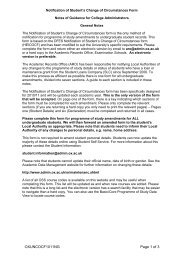Environmental Sustainability Report - University of Oxford
Environmental Sustainability Report - University of Oxford
Environmental Sustainability Report - University of Oxford
You also want an ePaper? Increase the reach of your titles
YUMPU automatically turns print PDFs into web optimized ePapers that Google loves.
<strong>University</strong> <strong>of</strong> <strong>Oxford</strong> <strong>Environmental</strong> <strong>Sustainability</strong> <strong>Report</strong> 2010/114Carbon reductionThe <strong>University</strong> increased its absolutebuildings-related emissions by 2.2% (from79,612tCO 2 in 2009/10 to 81,362tCO 2in 2010/11). However, emissions persquare metre floor space fell by 2.9%.The emissions increase was due to theGraph showing how much the <strong>University</strong>needs to reduce its emissions by 2020:Tonnes <strong>of</strong> CO290,00080,00070,00060,00050,00040,00030,00020,00010,00041,28177, 93765,980Actual emissions frombuildings and owned vehiclesBusiness as usual 2020 projectionHEFCE 2020 targetPreferred CarbonManagement Scenario29,500m 2 expansion <strong>of</strong> the <strong>University</strong>estate (Earth Sciences building, SwindonBook Store and <strong>Oxford</strong> MolecularPathology Institute). Total building-relatedenergy costs were £12,040,000.90/9191/9292/9393/9494/9595/9696/9797/9898/9999/0000/0101/0202/0303/0404/0505/0606/0707/0808/0909/1010/1111/1212/1313/1414/1515/1616/1717/1818/1919/2020/21YEAR37,60976,88544,152600500We set carbon reduction targetsIn 2011 the <strong>University</strong> agreed thefollowing carbon reduction targets:reduce carbon emissions by 11% belowthe 2005/6 baseline by 2015/16reduce carbon emissions by 33% belowthe 2005/6 baseline by 2020/21We published a CarbonManagement StrategyBased on current trends, <strong>University</strong>emissions are likely to reach 76,885tCO 2by 2020. To meet our targets, we mustreduce emissions to 58,722tCO 2 by2015/16 and 44,152tCO 2 by 2020/21.The Carbon Management Strategyoutlines how the <strong>University</strong> can meet itstargets by using energy more efficiently,investing in energy saving equipment andenergy efficient buildings.Total (t)We produced our own electricity2,445.8530The Biochemistry building’s solar5971.72photovoltaic installation generated 93.815,700 kWh <strong>of</strong> electricity comparedto 3,500 kWh last year – an increase<strong>of</strong> 63%. FAI Farms – tenants on the<strong>University</strong> owned Wytham Estate –installed photovoltaics on the farm’sro<strong>of</strong>s to generate renewable electricity.We created an onlineEnergy ToolkitThe Energy Toolkit contains top tips forstaff and students on how to use energymore efficiently:www.ox.ac.uk/staff/news/energy_toolkit.htmlIn 2012 the <strong>University</strong> will finalise its carbonreduction plan and continue to reducecarbon as part <strong>of</strong> its 10:10 Campaign.600400
















